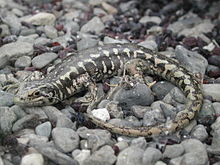
The copper skink is a skink of the family Scincidae that is endemic to the North Island of New Zealand.

The New Zealand striped skink is a rare species of medium-sized skink endemic to New Zealand. Found in the North Island, Great Barrier Island and Little Barrier Island, the species is primarily arboreal, living in dense native tree canopies.

Oligosoma alani,, also known as the robust skink is the largest endemic skink to New Zealand. The robust skink is in the family Scincidae and found in the protected nature reserves of the Mercury Islands in the North Island of New Zealand. The robust skink has an at risk - recovering conservation status.

McGregor's skink is a species of lizard in the family Scincidae. The species is endemic to New Zealand.
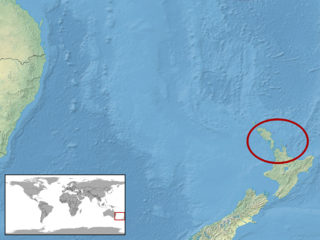
The marbled skink is a species of skink in the family Scincidae. The species is endemic to New Zealand.

Whitaker's skink, also known commonly as Whitaker's New Zealand skink, is an endangered species of skink, a lizard in the family Scincidae. The species is found only in New Zealand.

Falla's skink, also known commonly as the Three Kings skink, is a species of lizard in the family Scincidae. The species is native to New Zealand.
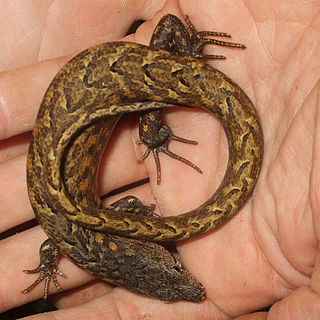
The chevron skink is a large species of skink that is endemic to New Zealand. Previously found across Northland and the northern Auckland Region, it is now found only on the Great Barrier and Little Barrier islands in the Hauraki Gulf. A cryptic forest dweller, it can hide underwater. The chevron skink is the longest species of skink in New Zealand, reaching lengths of up to 340 mm (13 in). It is under threat from introduced rats.

Oligosoma infrapunctatum, the speckled skink, is a species of skink in the family Scincidae. It is endemic to New Zealand.

Oligosoma suteri, known commonly as Suter's skink, the black shore skink, the egg-laying skink, and Suter's ground skink, is a species of lizard in the family Scincidae. The species is endemic to New Zealand, found in fragmented populations on the mainland of the Coromandel Peninsula as far south as the Coromandel Peninsula, and on offshore northern islands of New Zealand.
Hardy's skink is a species of skink, a lizard in the family Scincidae. The species is endemic to the Poor Knights Islands of New Zealand.
The slight skink is a skink of the family Scincidae, endemic to the far north of the North Island of New Zealand. The precise distribution is unknown; currently it is only known from localities in the Te Paki region of Northland. It closely resembles the copper skink, Oligosoma aeneum, and was considered to be a member of this species until recently when it was described as a new species using morphological, allozyme and DNA methods. O. levidensum is difficult to distinguish morphologically from O. aeneum, which is probably why it had not been recognised until recently. The main distinguishing feature is the slighter overall body form of O. levidensum compared to O. aeneum. The limbs of O. levidensum are reduced compared to O. aeneum and O. hardyi, the other members of the O. aeneum complex.
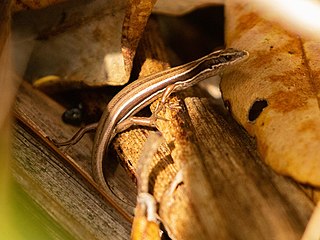
The moko skink is a species of lizard in the family Scincidae (skinks) that is endemic to New Zealand.

The Mokohinau skink, also known commonly as Towns' skink, is a species of lizard in the family Scincidae. The species is endemic to New Zealand.
The Aorangi skink is a species of lizards in the skink family. The species is native to New Zealand.

The Burgan skink is a nationally endangered species of skink native to New Zealand. It was described from a specimen found near the Burgan Stream, in the Rock and Pillar Range, Central Otago.
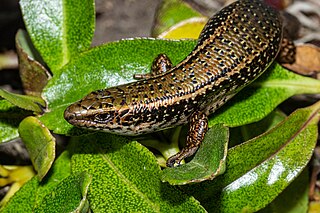
Oligosoma lineoocellatum, commonly known as the Canterbury spotted skink, is one of a species complex of several related spotted skink species from New Zealand.
The cobble skink in the family Scincidae is a skink species endemic to New Zealand, found only on a single small stretch of stony beach at Granity, on the West Coast. In 2016 it was on the brink of extinction, with declining numbers and a threatened habitat, and all known individuals were captured and taken to Auckland Zoo.
The Hokitika skink is a poorly-known and critically-endangered species of lizard in the family Scincidae (skinks) found only in the Hokitika area on the West Coast of New Zealand.
The Westport skink is an undescribed species of lizard in the family Scincidae (skinks) known from just a single museum specimen, collected near Westport on the West Coast of New Zealand.
